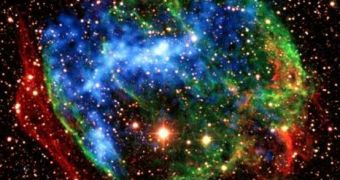Astronomers using the Japan-US Suzaku telescope have recently discovered fossilized traces in two supernova remnants, which bear witness to the tremendous fireballs that formed at the two locations just after the stars that went supernova exploded. When such a cosmic event occurs, experts believe that the temperatures inside the structures can grow to about 10,000 times that currently being registered on the surface of our Sun. The thing about the two new remnants is that they keep this fossil record of what happened even thousands of years after the cataclysmic event that created them.
“This is the first evidence of a new type of supernova remnant – one that was heated right after the explosion,” Institute of Physical and Chemical Research scientist Hiroya Yamaguchi, from Japan, explains. He adds that an average supernova remnant, the halo of matter and gas that remains after the core of the star implodes, tends to cool relatively fast, as it is being dispersed out from the star's former core. Gradually, as in thousands of years down the line, the huge amounts of interstellar gas that slam it nonstop heat it up again.
While analyzing the Jellyfish Nebula, in the constellation Gemini, the research team discovered peculiar and unusual traits in a remnant called IC 443. While analyzed in X-ray wavelengths, the structure, located some 5,000 light-years away, revealed a very interesting make-up. Using Suzaku's highly advanced observation capabilities, the group discovered a number of strange atoms, which could have not been produced in a normal supernova explosion. “These structures indicate the presence of a large amount of silicon and sulfur atoms from which all electrons have been stripped away,” Yamaguchi says.
He adds that temperatures in excess of 30 million degrees Fahrenheit (17 million degrees Celsius) are required in order for this to happen. Additionally, these naked nuclei emit X-rays as they continuously strive to claim back electrons. The flow of X-rays from the remnant hints at a temperature of about seven million degrees Celsius. “These ions cannot form in the present-day remnant. Instead, we're seeing ions created by the enormous temperatures that immediately followed the supernova,” the expert shares.
In a research paper published in the latest issue of The Astrophysical Journal, the group reports that each individual atoms may require a few thousand years before it manages to recapture one of its electrons. The reason why the Jellyfish Nebula still retains its hot electrons even today is the fact that, once the original force of the supernova blast clears that cocoon of dust and gas around the dying stars, it makes its way into the interstellar medium. When this happens, the likelihood of atoms colliding with each other, and therefore changing their structures and temperatures, dims considerably.

 14 DAY TRIAL //
14 DAY TRIAL //